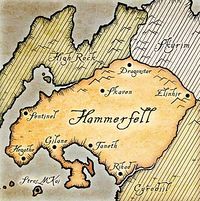Lore:Kingdom of Hammerfell
The Kingdom of Hammerfell that emerged during the Interregnum can be considered the successor to the Yokudan Empire, given the Na-Totambu ruling class took power and reverted Hammerfell back to a hereditary monarchy.[1] Before being absorbed into the Second Empire, Hammerfell was ruled by the Phyllocid Dynasty under High King Ar-Azal of Hegathe. King Ar-Azal was best remembered for healing the rift between the Na-Totambu ruling class and the warriors of the Ra Gada by marrying the daughters of their greatest Grandees.[2]
Under the provincial organization of the Second Empire, the role of High King was seemingly abolished as Ar-Azal became known the last king of his dynasty. Instead, the Na-Totambu and Ra Gada (now known as Crowns and the Forebears respectively) would go on to aid Cyrodiil's administration of Hammerfell. The Crowns retained the rights of noble council and the Forebears were granted rights of ownership within their tribal districts.[3] While there was no ruling monarchy, other titles and roles were known to exist at this time. High-ranking Crown nobles were called Magnifico and Magnifica, depending on gender.[4] Similarly, Grandee and Grandeyas were titles associated with various roles, including provincial governance, leading armed forces or members of the court.[5]
Interregnum[edit]
After the fall of the Second Empire in 2E 430, control of Hammerfell reverted back to the hereditary monarchy of the Na-Totambu, giving birth to the various kingdoms of Hammerfell. The new High King, in a bold move, shifted the capital from Hegathe to the more prosperous Forebear city of Sentinel, which had, by this time, mastered a third of the trade of the Iliac Bay.[1]
In the mid-Second Era, King Ramzi the Distrait ruled the Kingdom of Sentinel, but was self-serving and weak-willed and failed to protect his subjects from the Knahaten Flu. As death spread to his courtiers, Ramzi sealed himself within Samuruik palace and slowly starved to death, leaving the kingdom in despair. A young Forebear noble named Fahara'jad, descendant of Ar-Azal, traveled from Bergama and declared himself king of Hammerfell.[3] Support for the new king wasn't unanimous and Hammerfell wasn't unified under Fahara'jad. The Crown nobility in the southern cities of Hegathe, Gilane, Taneth and Rihad supported Grandee Zizzeen's claim to throne instead.[6][7] The Crowns suspected King Ramzi was usurped and acted with vehement repudiation against Fahara'jad, however Forebear viziers and northern chieftains ratified his accession.[3]
Around this time, the Forebears were progressives who firmly support the Daggerfall Covenant while the traditionalists Crowns rejected the practices of Tamriel and clung to their old ways.[8] Possibly sensing an uprising from the south, Fahara'jad allied himself with the Daggerfall Covenant to strengthen his position and pronounced himself High King of all Hammerfell, and even arranged the marriage of his daughter to High King Emeric of High Rock.[3][9] This action further infuriated the Crown nobility in the south, such as the royal family of Hegathe, as they openly opposed Fahara'jad's accession. Despite being unable to challenge his claims, they secretly plotted against and spied on Fahara'jad's kingdom.[3][6][10] While Fahara'jad ruled Sentinel, the Alik'r and beyond, its unknown if Hammerfell's other kingdoms, such as the Kingdom of Taneth, recognised him as High King.[11][12]
The Tiber War[edit]
The line of High Kings that ruled from Sentinel continued with Thassad II, but the city had switched to the rule of the Crowns. As the conquests of Tiber Septim began to expand and enroach on his domain, Thassad II resisted all forms of Imperial invasion. When the High King passed away in 2E 862 the capital was retaken by the Forebears under the command of Baron Volag, ensuing a vicious civil war between the Crowns and Forebears. When the latter enlisted the help of the Third Empire, the Forebears gained the advantage and resulting in the Crowns losing their territories until Stros M'Kai was left. The Battle of Stros M'Kai was won and the Empire swiftly took control over all of Hammerfell, imposing several provisional governors to rule its regions. Both factions reconciled a year later after an uprising against the Empire, which forced Tiber Septim to sign a more favorable treaty that formally established the Imperial Province of Hammerfell. Sentinel, however, remained as its provincial capital.[13][14][15] It is unknown when the next High King ascended to the throne after Hammerfell was absorbed into the Empire, but the rift in Hammerfell society was not mended.[16]
Third and Fourth Eras[edit]
During the Imperial Simulacrum the War of the Bend'r-mahk erupted in 3E 396. Skyrim defeated the forces of Hammerfell and High Rock and claimed many miles of the eastern parts of those provinces, including the cities of Elinhir and Jehanna.[17] Some of these territories were claimed to have been lost in previous wars at the expense of Skyrim.[18] By 3E 403 King Camaron of Sentinel was in power during the province's short but vicious land dispute with Daggerfall over the island of Betony.[19] Following the Miracle of Peace in 3E 417, Sentinel under King Lhotun greatly expanded to take over the entire northern coast of Hammerfell.[16][20]
Centuries later, the Thalmor of the Aldmeri Dominion would attempt to seize control of Hammerfell from the Third Empire. Emperor Titus Mede II's refusal to concede to Thalmor demands triggered the Great War in 4E 171. Aldmeri forces crossed western Cyrodiil and invaded Hammerfell's southern coast, easily sweeping through the scattered resistance put up by the disunited Redguards. Initially only seeking to conquer Hammerfell, the Dominion launched a full-scale invasion of Cyrodiil when it realized the Empire was weaker than previously believed. Imperial fortunes took a turn for the better in Hammerfell two years later, when a Forebear army from Sentinel broke the siege of the Crown city of Hegathe, leading to the reconciliation of the two factions. After the Empire's hard-won victory in the Battle of the Red Ring in 4E 175, the Empire and Dominion signed the White-Gold Concordat and ended the war. Outraged that the terms of the treaty called for a large portion of southern Hammerfell to be turned over to the Dominion, however, the Redguards soundly rejected it. Titus II was forced to officially renounce Hammerfell as an Imperial province to preserve the peace, and fighting between the Aldmeri and Redguards continued. In 4E 180, the Dominion agreed to the Second Treaty of Stros M'Kai and finally withdrew from the region, leaving Hammerfell an independent albeit devastated nation.[21]
Known Monarchs[edit]
- Second Era (Under the Second Empire)
- Second Era (During the Interregnum)
- Ramzi the Distrait (2E ? - 2E 5??) [3]
- Fahara'jad (2E 5?? - 2E ?) [3]
- Thassad II (2E ? - 2E 862) [1]
- Queen-Regent Iszara (2E 864 - ?) [UOL 1]
Gallery[edit]
Notes[edit]
- ^ Makala is described in one source as an elderly and infamous ruler, and in another source as the father of King Fahara'jad. He is also supposedly from the linage of King Ar-Azal and King Ja-Fr. Because King Fahara'jad became king immediately after Ramzi the Distrait, Makela could not have ruled in between these two rulers, making his placement unknown.
References[edit]
- ^ a b c Pocket Guide to the Empire, 1st Edition: Hammerfell — Imperial Geographical Society, 2E 864
- ^ a b c The Worthy Ar-Azal, His Deeds
- ^ a b c d e f g The Improved Emperor's Guide to Tamriel: Hammerfell — Flaccus Terentius, 2E 581
- ^ Magnifica's Sundas Wear in ESO
- ^ Grandee Husni in ESO
- ^ a b c d The Royal Lineage of Sentinel
- ^ Grandee Zizeen Teacups contraband item in ESO
- ^ Grandee Husni's dialogue in ESO
- ^ Bottle of Fennec Musk Perfume contraband item in ESO
- ^ Sacrilege and Mayhem in the Alik'r — Doctor Tazhim of the Bureau of Outlander Affairs
- ^ Banner of Taneth contraband item in ESO
- ^ Travel Itinerary
- ^ Pocket Guide to the Empire, 1st Edition: The Elsweyr Confederacy — Imperial Geographical Society, 2E 864
- ^ Introduction text in Redguard
- ^ Events of Redguard
- ^ a b Pocket Guide to the Empire, 3rd Edition: The Ra Gada: Hammerfell — Imperial Geographical Society, 3E 432
- ^ Pocket Guide to the Empire, 3rd Edition: The Throat of the World: Skyrim — Imperial Geographical Society, 3E 432
- ^ Pocket Guide to the Empire, 3rd Edition: The Sons and Daughter of the Direnni West: High Rock — Imperial Geographical Society, 3E 432
- ^ The War of Betony — Vulper Newgate, 3E 404
- ^ The Warp in the West — Ulvius Tero
- ^ The Great War — Legate Justianus Quintius
- ^ Imperial Napkin Holders item description in ESO
- ^ a b The All-Beneficent King Fahara'jad
- ^ King Makala's Ear Piece item description in ESO
- ^ The Brothers of Darkness — Pellarne Assi
Note: The following references are considered to be unofficial sources. They are included to round off this article and may not be authoritative or conclusive.
- ^ Kurt Kuhlmann's comments on Decrypting The Elder Scrolls Game Informer article



